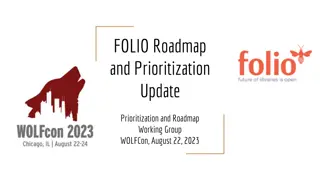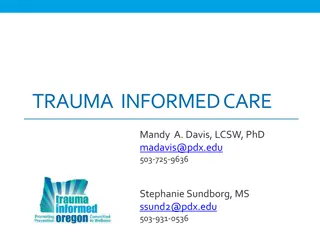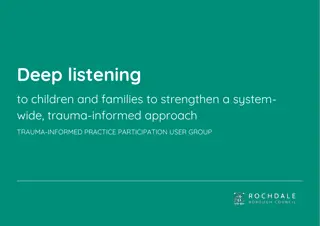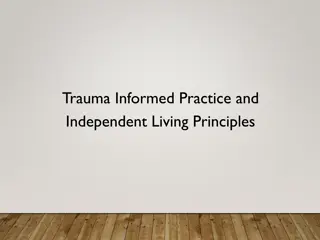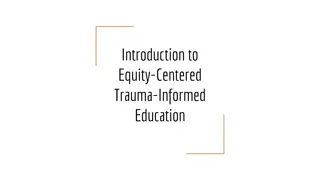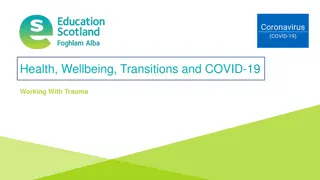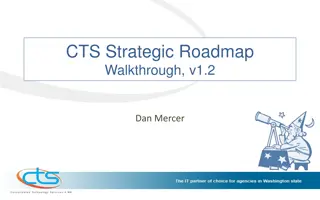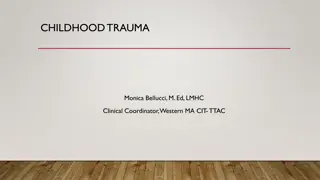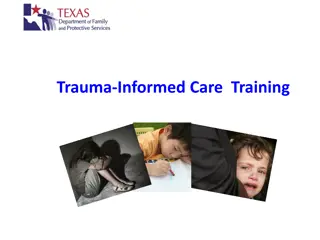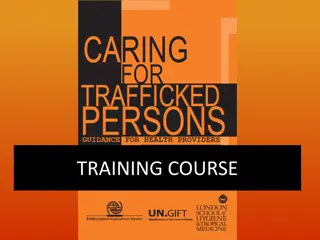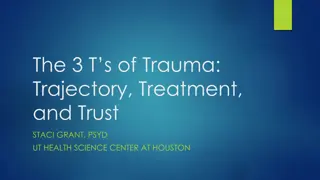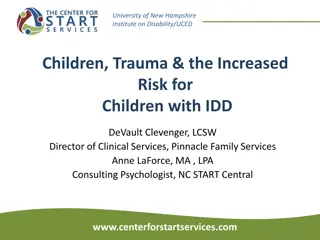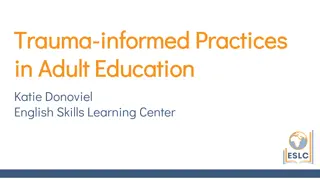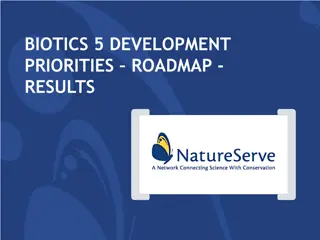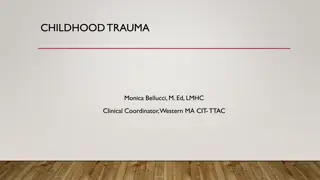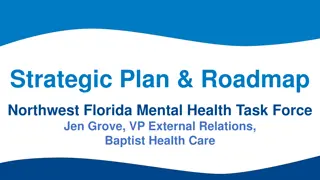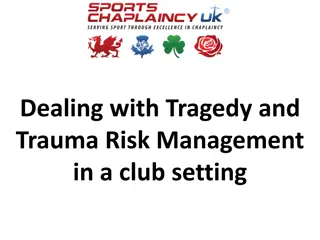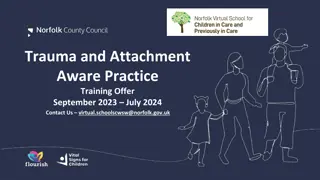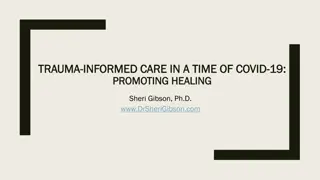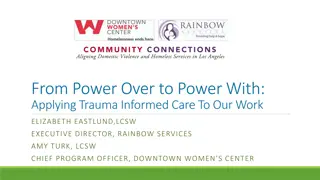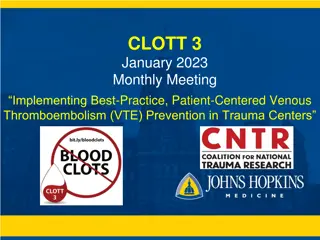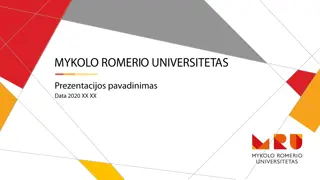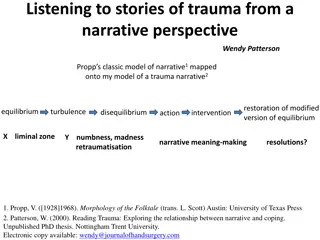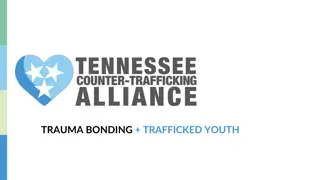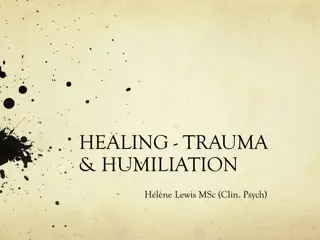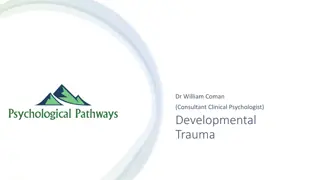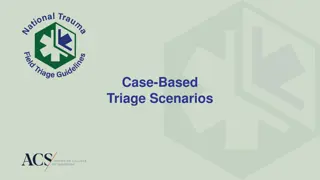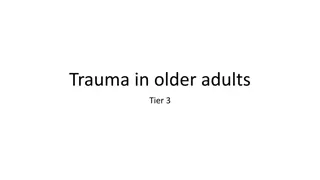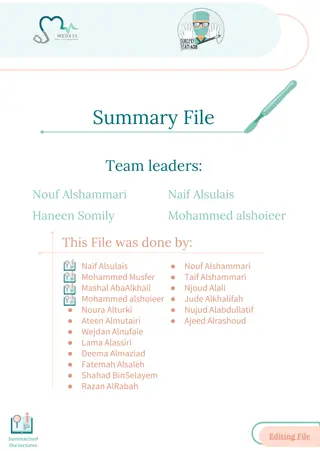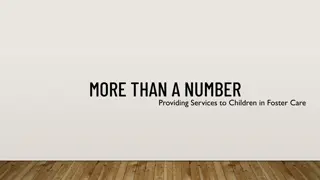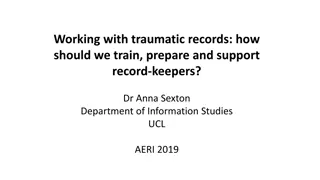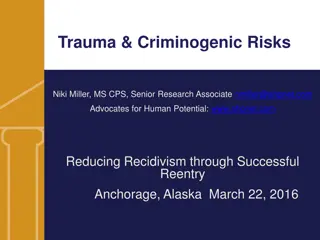Implementing Trauma-Informed Practices: A Strategic Roadmap
This comprehensive roadmap outlines the strategic approach, workstreams, and actions needed to scale and spread trauma-informed practices in Rochdale. It emphasizes design principles, workstream details, and a 12-month action plan to achieve a trauma-informed system. The roadmap aims to engage stakeholders, allocate resources effectively, and provide a clear path forward for progress in creating a trauma-informed borough.
Download Presentation

Please find below an Image/Link to download the presentation.
The content on the website is provided AS IS for your information and personal use only. It may not be sold, licensed, or shared on other websites without obtaining consent from the author. Download presentation by click this link. If you encounter any issues during the download, it is possible that the publisher has removed the file from their server.
E N D
Presentation Transcript
Road map Road map How to make Trauma-Informed practice a reality
About the Roadmap About the Roadmap The roadmap sets out the strategic approach, workstreams, and actions we will take as a system to scale and spread trauma-informed practice, starting from the existing bright spots. The roadmap sets out: The roadmap sets out: Design principles - these principles have guided the design of the strategy A scaling strategy based around a core team and sector- specific sub-groups The 4 workstreams for taking this work forward, and the respective roles for the core team and the sector-sub groups in each An action plan for the next 12 months to maintain momentum and progress The purpose of the roadmap is to: The purpose of the roadmap is to: Explain our strategic approach to key stakeholders Galvanise resources and activity across the system Provide a clear way forward for Rochdale in the short- term for making progress towards a trauma-informed system
Becoming a trauma Becoming a trauma- -informed borough informed borough Through exploring existing good practice in the system, and understanding the barriers to becoming a trauma-informed borough, the Design Group established some design principles to inform the roadmap. LEARNING FROM ROCHDALE DESIGN PRINCIPLES Everyone Everyone can apply trauma-informed principles in their work, from leaders to casual staff, from universal to specialist services and beyond. Communicate a consistent vision Communicate a consistent vision with tailored approach to meet the different needs of these job roles and sectors Becoming trauma informed is a personal journey Becoming trauma informed is a personal journey for individuals. A training day alone is not enough Create opportunities for people to have AHA moments Create opportunities for people to have AHA moments where they see the impact of trauma and the impact of TiP Everyone is busy doing the day job Everyone is busy doing the day job, and it is easy for immediate priorities to distract people from learning and reflecting Make it easy for people Make it easy for people to learn about and apply trauma- informed principles. This is not about doing new things, but doing the same things differently Organisational culture and systems can be barriers Organisational culture and systems can be barriers to individuals applying trauma-informed principles to their work Support leaders to understand trauma Support leaders to understand trauma- -informed principles and to change the ethos of the organisation informed principles 3
Our approach Our approach We want a consistent definition and language around trauma- informed practice, and to adapt our practice to the context and expertise in different parts of the system. Children s and Families Health VCS We will do this through: We will do this through: Shared Practice and Resources A central core team central core team to develop shared training and resources and support learning Sector Sector- -specific subgroups specific subgroups to tailor resources, champion good practice and identify barriers to becoming more trauma-informed Schools Adult Services Police and Justice 4
Possible governance and support structure Possible governance and support structure Children and Young People s Partnership Children s services transformation team Steering Group Safeguarding Partnership Provides governance support to steering group and design group Provides operational support for the 4 workstreams Design group Sector-sub groups led by Sector champions
System level workstreams Core team Core team COMMS TRAINING TOOLS AND RESOURCES LEARNING AND IMPACT Establish service-level survey to report on progress towards TiP Recruit and support champions Tell the story of TiP and why it matters Map the different training offers on TiP In Rochdale / GM Own and maintain tools to support self-assessment in TiP and deep listening with C&F in each service Establish partnership survey on use of TiP Communicate senior buy-in and champions Undertake training needs assessment across the system Resource the analysis of findings from org and workforce surveys Encourage participation in sub- groups, surveys and use of tools Develop competency framework for TiP Collate best practice from across sectors Define and resource:an basic training offer for everyone and a leadership training offer Share learning and impact with DG and SG Collate and share tools from across sectors Communicate journey and impact 6
System level workstreams Champions and sub groups Champions and sub groups COMMS TRAINING TOOLS AND RESOURCES LEARNING AND IMPACT Promote the completion of system-level surveys and share findings Adapt self-assessment and deep listening tools to be sector-specific Identify one or more TiP champions Identify existing training offers in the sector Adapt the TiP story using relevant personas to communicate Develop a sector-specific competency framework. Consider tracking or measuring impact on sector-specific metrics Provide opportunities to share self-assessment findings within the sector Map training needs in the sector - who and how Identify meetings that can act as sector sub-group. Share sector learning with the design and steering group Identify and share best practice within the sector Put forward proposals for training and identify possible resources Identify, events and conferences to promote TiP tools and resources and good practice Share system challenge and asks with the design and Steering group 7
Role of the TiP champion Role of the TiP champion Within each sub-group: Act as champion/leader for trauma-informed practice within their sub-group, including Promoting trauma-informed ways of working across our identified TIP features (i.e. recording; relationships; safe environments etc) Highlighting best practice in the sector and sharing widely with others Identify opportunities for collaboration and shared learning with other sub-groups so good practice can be scaled At a system level: Meetings with TIP champions (Design Group) to support the delivery of the TIP roadmap (incl. Opportunities for joint training) Connect with TIP champions to find solutions to common challenges/barriers, working together to leverage senior support Connect with TIP champions to share opportunity and continue to create learning on best practice
Scaling and spreading Trauma Scaling and spreading Trauma- -informed practice informed practice Core team Core team Champions + sub groups Champions + sub groups Leaders Leaders Talk regularly about the importance of trauma- informed practice Use existing communications channels to share the communications package Find more champions in different teams and services Support champions to have the time and authority to promote trauma-informed practice Look for existing spaces and groups to talk about trauma informed practice Embed trauma-informed principles in all training and workforce development Set up networks and communities of practice to talk about trauma Use trauma-informed principles in policies, strategies and decisions about resources Use trauma-informed principles in wider transformation projects and commissioning strategies Look for meaningful opportunities to involve people with lived experience Listen to the lived experience of children, families and communities Celebrate great trauma- Everyone informed work through awards and events Bring opportunities and resources to the Steering Group Share learning and listen to the learning of other sectors
Action plan to Spring 23 Action plan to Spring 23 May 23 May 23 Summer 23 Autumn 23 Winter 23 Spring 24 COMMS COMMS Personas and tools shared across the borough Promote training from people with lived experience Borough-wide TiP conference to share learning so far Comms package Comms package designed and agreed designed and agreed Commitment to TiP publicised Alexis Beaumont TRAINING TRAINING Develop workforce trauma competency framework Design a delivery model for a partnership training offer Agree resources for partnership training offer Training champions Training champions identified identified Mapping of existing trauma training Lucy Chartres TOOLS AND TOOLS AND RESOURCES RESOURCES Sector sub groups adapt tools for their sector Refresh of tools and resources based on feedback Sector champions promote tools in the sector and identify other useful tools Tools developed and Tools developed and agreed agreed Lead tbc LEARNING AND LEARNING AND IMPACT IMPACT Borough-wide org impact survey completed Sector champions Sector champions identified identified Sector-sub groups established Sector champions collect examples of good practice, barriers and learning Sam Sirisambhand








